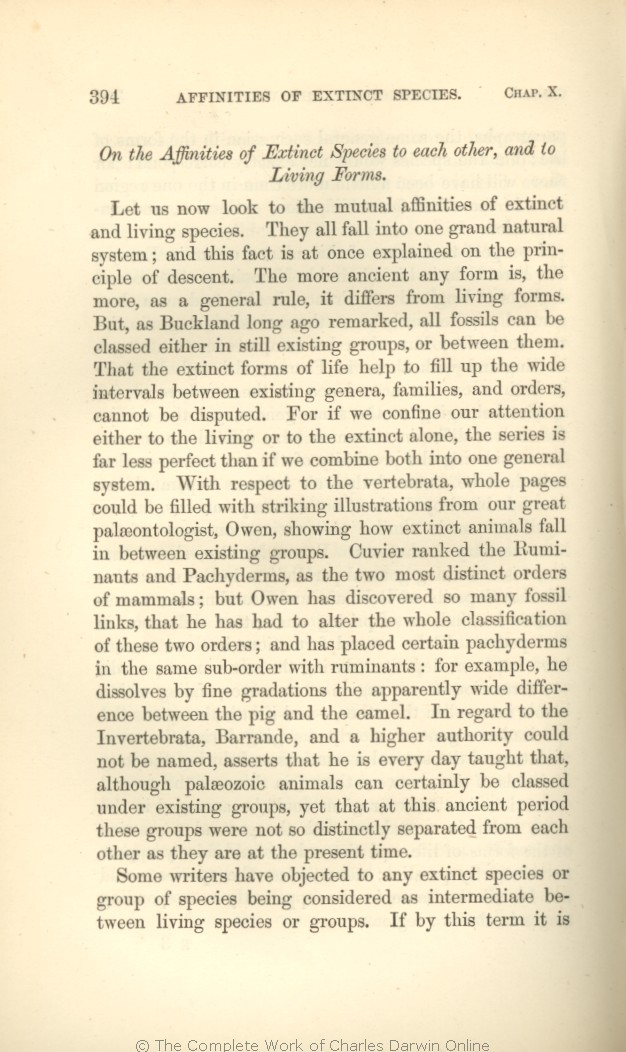Let us now look to the mutual affinities of extinct and living species.
They | They 1859 1860 1861 1866 1869 | | All 1872 |
| all 1859 1860 1861 1866 1869 | | fall 1872 |
| fall 1859 1860 1861 1866 1869 | fall 1872 |
| one grand natural system; 1859 1860 1861 1866 |
| a few grand classes; 1869 1872 |
| all fossils can 1859 1860 1861 1866 |
| all extinct species can 1869 |
| extinct species can all 1872 |
| wide 1859 1860 1861 1866 | wide 1869 1872 |
| cannot be disputed. 1859 1860 1861 1866 1869 |
| is certainly true; but as this statement has often been ignored or even denied, it may be well to make some remarks on this subject, and to give some instances. 1872 |
| For if 1859 1860 1861 1866 1869 | | If 1872 |
| alone, 1859 1860 1861 1866 1869 |
| species of the same class, 1872 |
| With respect to the vertebrata, whole pages could be filled with striking illustrations from our great palæontologist, Owen, showing how 1866 |
| With respect to the Vertebrata, whole pages could be filled with striking illustrations from our great palæontologist, Owen, showing how 1859 1860 1861 |
| With respect to the vertebrata, whole pages could be filled with illustrations from Owen, showing how 1869 |
| In the writings of Professor Owen we continually meet with the expression of generalised forms, as applied to 1872 |
| animals 1859 1860 1861 1866 1869 | | animals; 1872 |
| fall 1859 1860 1861 1866 1869 | | and 1872 |
| between existing groups. 1859 1860 1861 1866 1869 |
| the writings of Agassiz, of prophetic or synthetic types; and these terms imply that such forms are in fact intermediate or connecting links. 1872 |
| the two 1859 1860 1861 1866 1869 |
| two of the 1872 |
| mammals; 1859 1860 1861 1866 1869 | | mammals: 1872 |
| Owen has discovered 1859 1860 1861 1866 1869 |
| OMIT 1872 |
| links, 1859 1860 1861 1866 1869 | | links 1872 |
| that he 1859 1860 1861 1866 1869 |
| have been disentombed that Owen 1872 |
| classification 1859 1860 1861 1866 | | classification, 1869 1872 |
| of these two orders; 1859 1860 1861 1866 |
| OMIT 1869 1872 |
| ruminants: 1859 1860 1861 1866 1869 | | ruminants; 1872 |
| fine 1859 1860 1861 1866 1869 | fine 1872 |
| difference 1859 1860 1861 1866 1869 | | interval 1872 |
| 5 blocks not present in 1859 1860 1861 1866 1869; present in 1872 | | The Ungulata or hoofed quadrupeds are now divided into the even-toed or odd-toed divisions; but the Macrauchenia of S. America connects to a certain extent these two grand divisions.
No one will deny that the Hipparion is intermediate between the existing horse and certain older ungulate forms.
What a wonderful connecting link in the chain of mammals is the Typotherium from S. America, as the name given to it by Professor Gervais expresses, and which cannot be placed in any existing order.
The Sirenia form a very distinct group of mammals, and one of the most remarkable peculiarities in the existing dugong and lamentin is the entire absence of hind limbs, without even a rudiment being left; but the extinct Halitherium had, according to Professor Flower, an ossified thigh-bone "articulated to a well-defined acetabulum in the pelvis," and it thus makes some approach to ordinary hoofed quadrupeds, to which the Sirenia are in other respects allied.
The cetaceans or whales are widely different from all other mammals, but the tertiary Zeuglodon and Squalodon, which have been placed by some naturalists in an order by themselves, are considered by Professor Huxley to be undoubtedly cetaceans, "and to constitute connecting links with the aquatic carnivora."
|
| 1 blocks not present in 1859 1860 1861 1866; present in 1869 1872 | | Another distinguished palæontologist, M. Gaudry, shows that very
many of the fossil mammals discovered by him in Attica connect in the plainest manner
existing genera.
|
| that, 1866 | | that 1859 1860 1861 |
| although palæozoic animals can certainly be classed under existing groups, yet that at this ancient period these groups 1866 |
| palæozoic animals, though belonging to the same orders, families, or genera with those living at the present day, 1859 |
| Palæozoic animals, though belonging to the same orders, families, or genera with those living at the present day, 1860 1861 |
| so distinctly separated from each other 1866 |
| at this early epoch limited in such distinct groups 1859 1860 1861 |
| ..... 1866 | | now 1859 1860 1861 |
| are at the present time. 1866 |
| are. 1859 1860 1861 |
|









